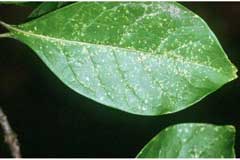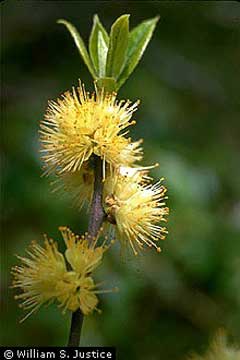 |
|
Robert H. Mohlenbrock @ USDA-NRCS PLANTS Database / USDA SCS. 1991. Southern wetland flora: Field office guide to plant species. South National Technical Center, Fort Worth. |
 |
| William S. Justice @ USDA-NRCS PLANTS Database |
Translate this page:
Summary
Physical Characteristics

 Symplocos tinctoria is an evergreen Shrub growing to 8 m (26ft 3in). It is in flower in May, and the seeds ripen in September. The species is hermaphrodite (has both male and female organs). The plant is not self-fertile.
Symplocos tinctoria is an evergreen Shrub growing to 8 m (26ft 3in). It is in flower in May, and the seeds ripen in September. The species is hermaphrodite (has both male and female organs). The plant is not self-fertile.
Suitable for: light (sandy), medium (loamy) and heavy (clay) soils and prefers well-drained soil. Suitable pH: mildly acid and neutral soils. It can grow in semi-shade (light woodland) or no shade. It prefers moist soil.
UK Hardiness Map
US Hardiness Map
Synonyms
Plant Habitats
Woodland Garden Secondary; Sunny Edge; Dappled Shade; Shady Edge;
Edible Uses
Edible Parts: Leaves
Edible Uses:
Leaves - raw. Thick and downy, they have a pleasant sweet smell and taste[245]. Chewed for their pleasantly sweet, slightly acid flavour that is refreshing and helps to ease thirst[183].
References More on Edible Uses
Medicinal Uses
Plants For A Future can not take any responsibility for any adverse effects from the use of plants. Always seek advice from a professional before using a plant medicinally.
Febrifuge Tonic
The bitter, aromatic roots have been used as a tonic[46, 82]. A decoction of the scraped roots has been used in the treatment of fevers[257].
References More on Medicinal Uses
The Bookshop: Edible Plant Books
Our Latest books on Perennial Plants For Food Forests and Permaculture Gardens in paperback or digital formats.

Edible Tropical Plants
Food Forest Plants for Hotter Conditions: 250+ Plants For Tropical Food Forests & Permaculture Gardens.
More

Edible Temperate Plants
Plants for Your Food Forest: 500 Plants for Temperate Food Forests & Permaculture Gardens.
More

More Books
PFAF have eight books available in paperback and digital formats. Browse the shop for more information.
Shop Now
Other Uses
Dye Mordant Wood
A yellow dye is obtained from the leaves, the bark and the fruits[1, 46, 82]. We have no specific information for this species but many species in this genus contain alum and can be used as mordants when dyeing[168]. Wood - soft, weak, light, close grained, easily worked[46, 82, 235]. It weighs 33lb per cubic foot[235]. Used for turnery[46, 82].
Special Uses
Scented Plants
References More on Other Uses
Cultivation details
Easily grown in any fertile soil[182]. Prefers a sunny position in a well-drained fertile acid to neutral soil[200]. Plants are often found growing in dense shade in the wild[82]. This species is not very hardy in Britain, it only succeeds outdoors in a sheltered position in the warmest counties of the country[182]. Forms of this species that are hardy in Britain might exist in the north of the plants range or at higher elevations[11]. This species is not a true evergreen, but in climates with mild winters the previous years leaves are not lost until after the new leaves come into growth[229]. Self-sterile, it needs cross-pollination with a different plant in the same species if seed and fruit are to be produced[182]. The flowers are sweetly perfumed[245]. The leaves also have a sweet smell[245]. Plants in this genus are notably resistant to honey fungus[200].
References Carbon Farming Information and Carbon Sequestration Information
Temperature Converter
Type a value in the Celsius field to convert the value to Fahrenheit:
Fahrenheit:
The PFAF Bookshop
Plants For A Future have a number of books available in paperback and digital form. Book titles include Edible Plants, Edible Perennials, Edible Trees,Edible Shrubs, Woodland Gardening, and Temperate Food Forest Plants. Our new book is Food Forest Plants For Hotter Conditions (Tropical and Sub-Tropical).
Shop Now
Plant Propagation
Seed - best sown in a cold frame as soon as it is ripe. Stored seed requires stratification and is best sown in a cold frame in late winter, it can take 12 months to germinate[11]. Prick out the seedlings into individual pots when they are large enough to handle and grow them on in the cold frame for their first winter. Plant out in late spring or early summer. Cuttings of half-ripe wood, 7 - 10cm with a heel, July/August in individual pots in a cold frame[78, 200]. Roots are formed in about 4 weeks. Good percentage[78].
Other Names
If available other names are mentioned here
Native Range
NORTHERN AMERICA: United States (Oklahoma, Alabama, Arkansas, Delaware, Florida (north), Georgia, Louisiana, Maryland, North Carolina, South Carolina, Virginia, Mississippi, Tennessee, Texas (east))
Weed Potential
Right plant wrong place. We are currently updating this section.
Please note that a plant may be invasive in one area but may not in your area so it's worth checking.
Conservation Status
IUCN Red List of Threatened Plants Status :

Growth: S = slow M = medium F = fast. Soil: L = light (sandy) M = medium H = heavy (clay). pH: A = acid N = neutral B = basic (alkaline). Shade: F = full shade S = semi-shade N = no shade. Moisture: D = dry M = Moist We = wet Wa = water.
Now available:
Food Forest Plants for Mediterranean Conditions
350+ Perennial Plants For Mediterranean and Drier Food Forests and Permaculture Gardens.
[Paperback and eBook]
This is the third in Plants For A Future's series of plant guides for food forests tailored to
specific climate zones. Following volumes on temperate and tropical ecosystems, this book focuses
on species suited to Mediterranean conditions—regions with hot, dry summers and cool, wet winters,
often facing the added challenge of climate change.
Read More
Expert comment
Author
(L.)L'Hér.
Botanical References
1143
Links / References
For a list of references used on this page please go here
Readers comment
| Add a comment |
|
If you have important information about this plant that may help other users please add a comment or link below. Only comments or links that are felt to be directly relevant to a plant will be included. If you think a comment/link or information contained on this page is inaccurate or misleading we would welcome your feedback at [email protected]. If you have questions about a plant please use the Forum on this website as we do not have the resources to answer questions ourselves.
* Please note: the comments by website users are not necessarily those held by PFAF and may give misleading or inaccurate information.
To leave a comment please Register or login here All comments need to be approved so will not appear immediately.
|
Subject : Symplocos tinctoria
|
|
|
|